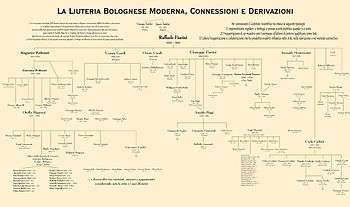Ansaldo Poggi



Ansaldo Poggi was born in Villafontana di Medicina (Bologna), 9 June 1893 and died in Bologna, 4 September 1984. He demonstrated his talent for the making of stringed instruments at a young age. His father, also an artisan, musician and amateur violinmaker, encouraged his son, steering him toward the arts. After the end of World War I he dedicated himself to the profession, taking up the craft again alongside his father while at the same time graduating from the Philharmonic Academy of Bologna. In 1921 he met up with the famous luthier Giuseppe Fiorini, of whom he was an adored disciple. In 1923 he won his first silver medal with a viola at the National Competition in Rome. [1]
In 1925, 1927 and 1929 he was awarded many gold medals, which resulted in his no longer being permitted to compete. With the passing of the years Poggi became stylistically independent of Fiorini, and was soon producing instruments of a shape and reflecting a taste all his own. He became an enormous success on both a national and international level.
Gian Carlo Guicciardi, Giampaolo Savini and Neldo Ferrari have to be considered his students.[2]
"Ansaldo Poggi is considered by most soloists the greatest violin maker of the 20th century. Most of his instruments are based on Stradivari model, sometimes on Guarneri and a personal model. During his life time, he made instruments for important musicians such as Mistislav Rostropovich, David Oistrakh, Nathan Milstein, Yehudi Menuhin, Isaac Stern, Aaron Rosand, and Uto Ughi, to name just a few. Violinist Aaron Rosand, sold his 10 million dollar Joseph Guarnerius violin in 2009 and now performs on an Ansaldo Poggi violin. Poggi made a total of 322 violins in his life time." - Poesis String Studio, Violin & Bow Expert
References
 |
| Part of a series on |
| Fiddle and Violin |
|---|
| Basic physics |
| Fiddlers |
| History of the violin |
| Luthiers |
| Musical styles |
| Violin technique |
| Violin construction |
| Violin family |
| Violinists |
- ↑ William Henley, Universal Dictionary of Violin & Bow Makers, Brighton 1959, 1973 and 1997
- ↑ Il Suono di Bologna, Da Raffaele Fiorini ai grandi maestri del Novecento". Catalogo della Mostra nella chiesa di San Giorgio in Poggiale, Bologna 2002. ISBN 88-85250-06-8
- Fiorini, Roberto; Frignani, Lorenzo (2007). Il liutaio Giuseppe Fiorini. Modena.
- Santoro, Elia (1988). Giuseppe Fiorini e i Cimeli Stradivariani. Cremona.
- Tito Gotti, Bologna 1991 and 1993, ISBN 88-85250-03-3
- Paradigmi. Forme nell'Artigianato, Bologna 1988 and 1989
- Daniele Benati - Pierluigi Giordani, Stanze bolognesi - La Collezione Lauro, Bologna 1994
- Artemio Versari, "Liuteria moderna in Emilia Romagna" 2002
- Artemio Versari, "La grande liuteria italiana" 2009
- Il Suono di Bologna, Da Raffaele Fiorini ai grandi maestri del Novecento". Catalogo della Mostra nella chiesa di San Giorgio in Poggiale, Bologna 2002. ISBN 88-85250-06-8
- Eric Blot, Un secolo di Liuteria Italiana 1860-1960 - A century of Italian Violin Making - Emilia e Romagna I, Cremona 1994. ISBN 88-7929-026-6
- Dictionary of 20th Century Italian Violin Makers - Marlin Brinser 1978
- Regazzi Roberto, In occasione del 250º anniversario della morte di Antonio Stradivari per onorare la figura di Giuseppe Fiorini, Maestro Liutaio - Bazzano (Bologna) 1861 - Monaco di Baviera 1934. Una Immagine e una Biografia per celebrare la donazione della Collezione Salabue di Cimeli Stradivariani alla Città di Cremona, Bazzano 1987
- The Strad, January 1984 Bologna, a living tradition of Violin Making
- Vannes, Rene (1985) [1951]. Dictionnaire Universel del Luthiers (vol.3). Bruxelles: Les Amis de la musique. OCLC 53749830.
- William, Henley (1969). Universal Dictionary of Violin & Bow Makers. Brighton; England: Amati. ISBN 0-901424-00-5.
- Walter Hamma, Meister Italienischer Geigenbaukunst, Wilhelmshaven 1993, ISBN 3-7959-0537-0
External links
- History at the Wayback Machine (archived 29 August 2003)
- Bolognese Violin Makers at the Wayback Machine (archived 3 September 2003)
- www.ilsuonodibologna.org former site at the Wayback Machine (archived 20 June 2003)